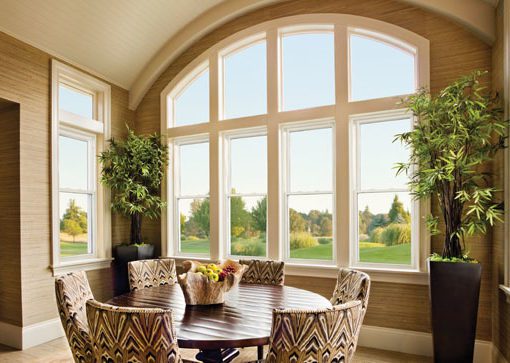Energy Efficiency Factors Important in Considering Replacement Windows
Heat Transfer Through Glass
In over 150 years, glass manufacturing has remained virtually the same. Windows in a 40-year-old home will transfer heat through the glass at about the same number of BTUs (British Thermal Units) as windows in a brand-new home. The solution to improving heat transfer and energy efficiency, however, is not in the glass but is in the upgrades to the glass. Testing with a standard heat lamp, a double-pane window with no upgrades will transfer approximately 200 BTUs through the glass. If you put your hand on the inside of the window glass, the glass will feel warm. Consequently, the atmosphere in the room adapts to this heat transfer and blocks some of the cooling that may be desirable.
Low E Coatings
Low E (low emissivity) coatings on the glass surfaces prevent some heat transfer, thereby improving the room’s atmosphere. It’s important to determine which type of Low E is needed. Low E2 is an energy-efficiency coating applied to the inside of the inner glass in a double-pane window. This is a basic upgrade that improves heat transfer, making this a good solution for windows that do not face the afternoon sun. Low E3 consists of a second coating applied to the inside of the outer glass. The two coatings work simultaneously to significantly improve heat transfer.
Argon Gas
An important energy efficiency factor in windows begins with the addition of gas. Argon is an inert gas which is colorless and odorless. This gas is commonly used in double-pane windows to add major improvements in heat transfer thereby lowering energy bills. Argon gas is used with Low E2 and Low E3 coatings to give the most benefit in keeping rooms cool and also warm in the winter when desired.
Last but not least, Low E3 Argon windows can reduce heat transfer to approximately 40 BTUs, a significant drop from standard double-pane windows with no upgrades. An extra benefit of Low E3 Argon is the ability to repel winter cold from penetrating the glass. This allows heat to remain in the room atmosphere when desired. The added benefit of reducing air conditioning costs as well as heating costs is one of the major reasons why customers upgrade to Low E3 Argon replacement windows.
Window Frames and Construction
Additionally, energy efficiency factors include the frame material and how it is manufactured. Vinyl windows are very long-lasting and maintenance-free. If purchased in standard colors offered by the manufacturer, vinyl windows generally have a lifetime warranty.
How the window is manufactured is crucial. The most long-lasting, securely framed window is a multi-fusion welded window in which a perfectly squared frame is produced in a special welding machine. This type of welding completely fuses the entire frame at one time. It is not “spot-welded†which may produce a window frame that deteriorates over time. Small structural changes in the foundation of a home often warp spot-welded window frames.
Double-Strength Glass
Most importantly, double-strength glass adds to the long-lasting integrity of a window. The extra strong glass holds up extremely well to impacting objects such as storm debris. Particularly, small stones kicked up by lawn mowers have done major damage to single strength window glass. Another important energy efficiency factor is the ability of double-strength glass to improve heat transfer. Additionally, Low E Argon upgrades can achieve the top energy efficiency. Single-strength glass would serve very little benefit with the energy-efficient upgrades available in today’s replacement windows.
America’s Best Choice Siding and Windows, serving Springdale, Fayetteville and Bentonville Arkansas, recommends vinyl Low E3 Argon replacement windows to offer the best benefit in energy efficiency available today to our customers. We install windows with multi-fusion welded frames and double-strength glass providing the longest-lasting maintenance-free products.

